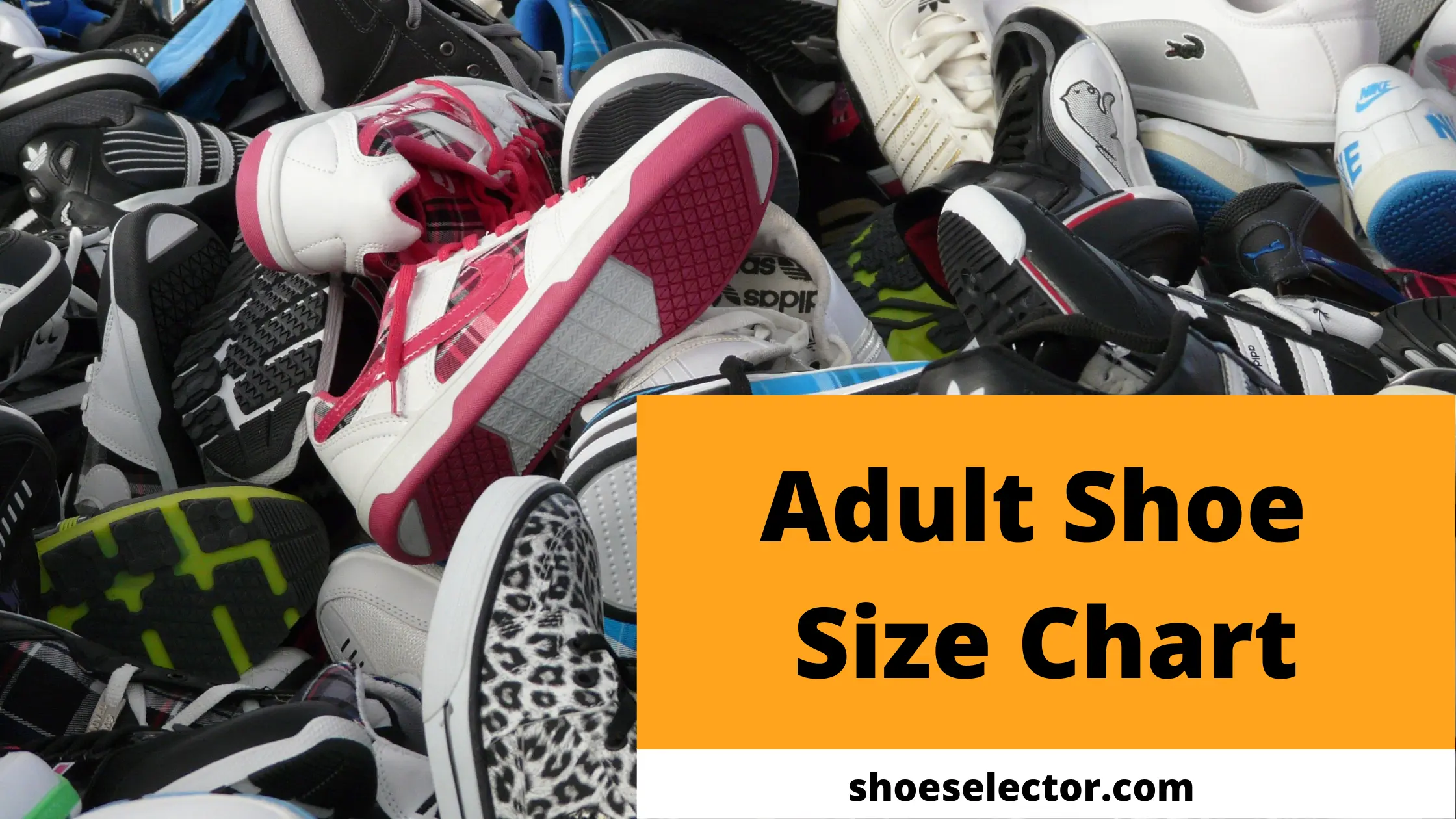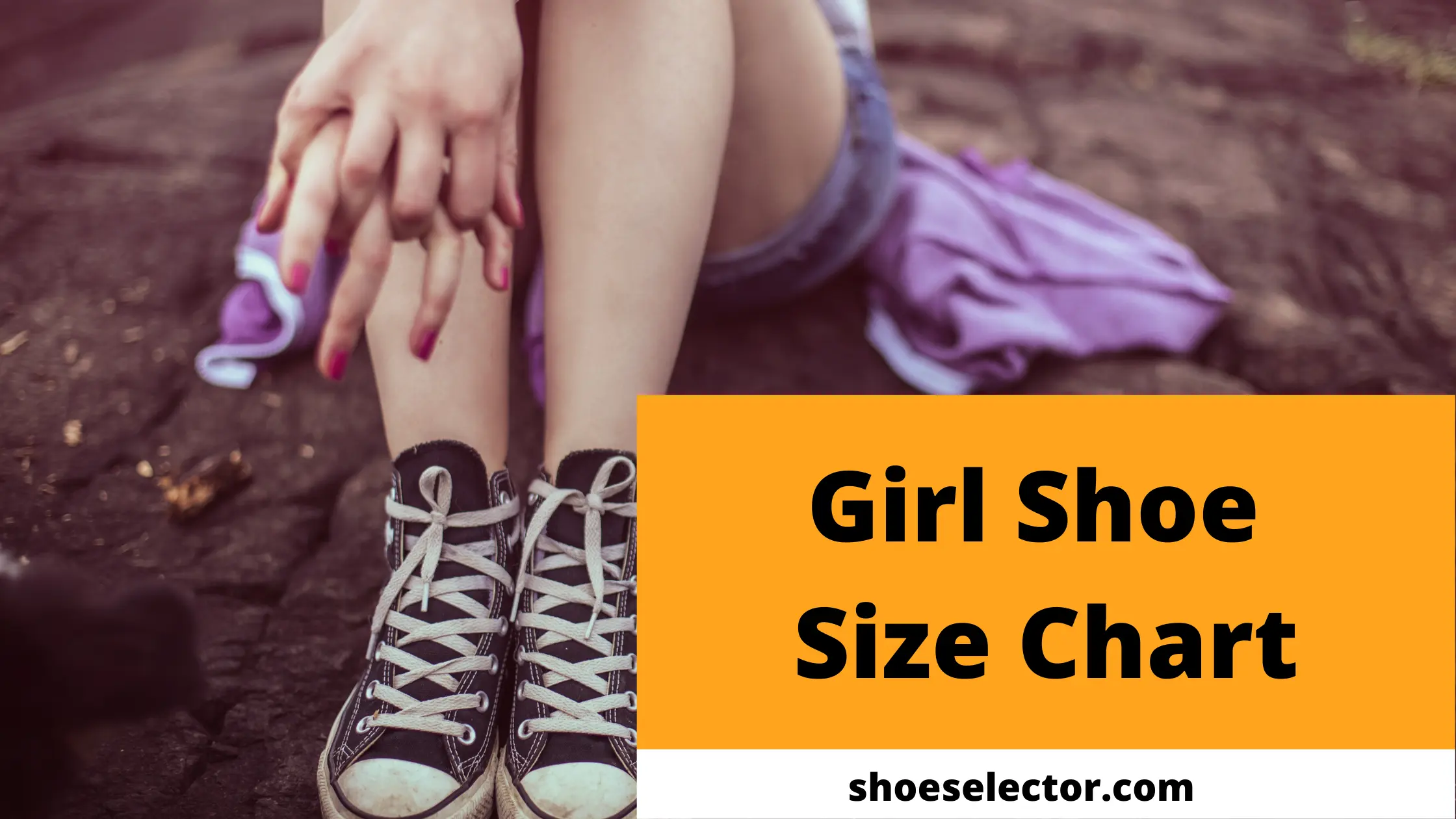To properly shop shoes for toddlers, infants, babies, children’s or kids you need to know the perfect size chart. Our guide will ensure that you get the right fit and avoid any awkwardness or discomfort while your child wears them. With so many different styles and brands of children’s shoes available, it can be tough to determine what size you need.
We make it easy for you to find the right size shoe for your child, no matter what brand or style you choose. Whether you’re looking for sneakers or sandals, we’ve got you covered. Plus, our easy-to-use sizing guide will make finding the right fit a breeze. Here, we’ll also provide an overview of how to read a children’s shoe size chart.
Click Here to Read About Toddler Size Guide
Click Here to Read About Infant Size Guide
Click Here to Read About Baby Size Guide
Click Here to Read About Children’s Size Guide
Click Here to Read About Kids Size Guide
What are Toddler Shoe Sizes?
Toddler shoe sizes vary depending on the make and model of shoe, but there is a general sizing guideline you can follow. For boys, toddler shoe sizes typically range from size 4 to size 7. For girls, toddler shoe sizes range from size 3 to size 6. As your toddler grows older, their shoe size will also increase. So it’s important to keep track of your toddler measurements and periodically check in with a retailer to ensure you’re buying the correct sized shoes.
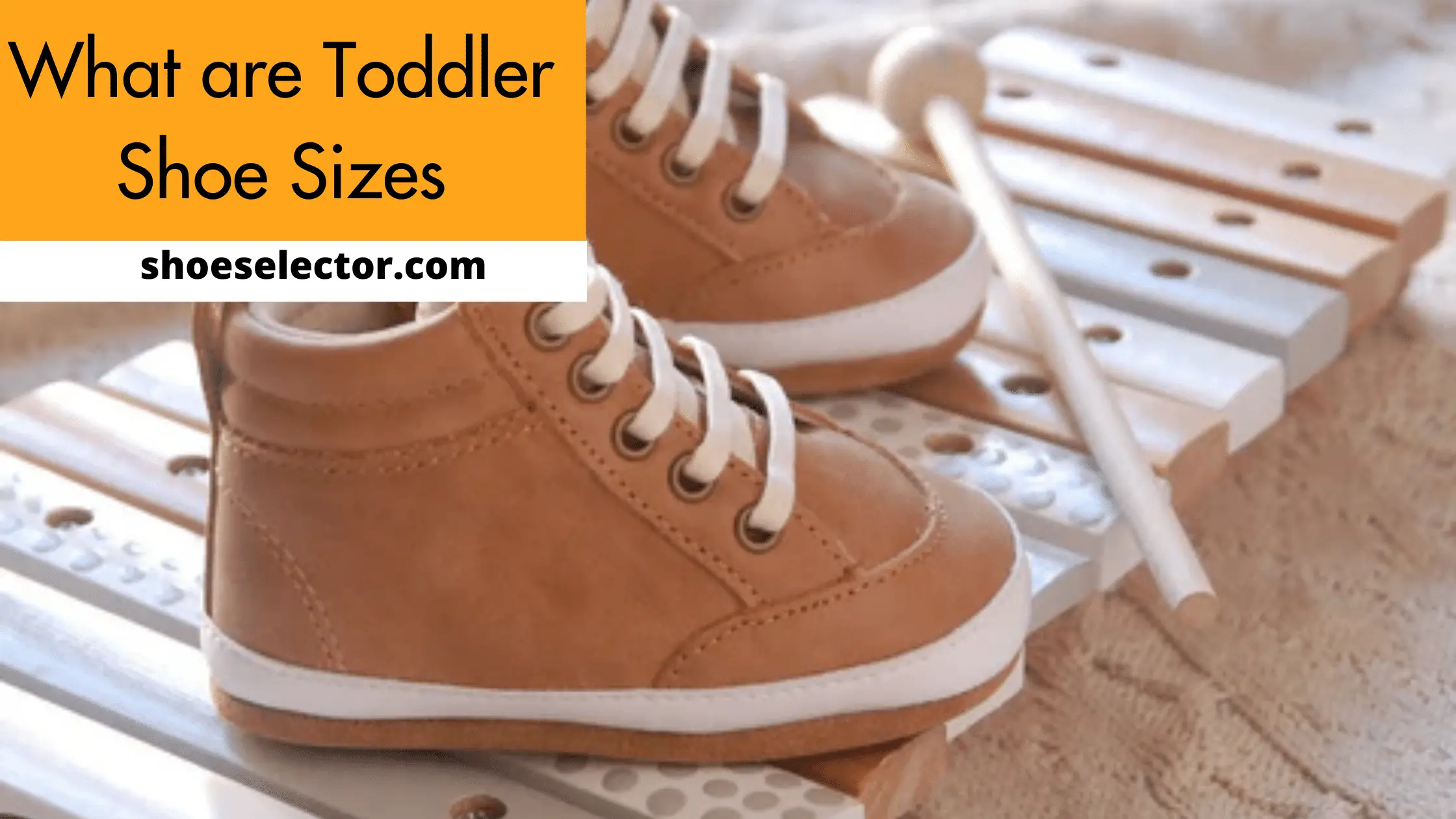
Why is it Important to Measure Your Toddler’s Feet?
Toddlers' feet grow very quickly and can vary in size from one day to the next, so it’s important to measure them regularly and keep track of their growth. Shoes that are too small or too large can cause a variety of problems, such as blisters, calluses, ingrown toenails, and even deformities. So it’s definitely worth taking the time to measure your toddler’s feet on a regular basis.
How to Measure Your Perfect Toddler Shoe Size Feet?
- Place a piece of paper on the floor and have your toddler stand on it.
- Use a pencil to trace around their feet. Make sure to keep the pencil close to their foot, and don’t press too hard!
- Measure the length and width of their feet. To get the length, measure from their heel to their big toe. To get the width, measure from the widest part of their foot.
- Use a toddler shoe size chart to find their size.
Once you have your toddler measurements, you’re ready to start shopping for shoes.
How to Make Sure the Toddler Fit is Correct?
When you’re trying on shoes for your toddler, there are a few things you should keep in mind. Here are some tips for making sure the shoes fit correctly:
- Make sure there’s enough room
- Check for support
- Make sure they can put the shoes on by themselves
- Have them walk around
- Watch for redness or rubbing
What is the Average Shoe For Toddlers by Age?
The average shoe size for toddlers is between 4 and 8. However, this can vary depending on the toddler age and how fast their feet are growing.
What is the Average Toddler Shoe Size by Age in the UK, US, EU, and Japan?
The average shoe size for toddlers in the UK is between 4 and 8. In the US, the average shoe size for toddlers is between 4 and 10. In Europe, the average shoe size for toddlers is between 20 and 30. And in Japan, the average shoe size for toddlers is between 11 and 16.
Toddlers Shoe Size Chart & Conversion:
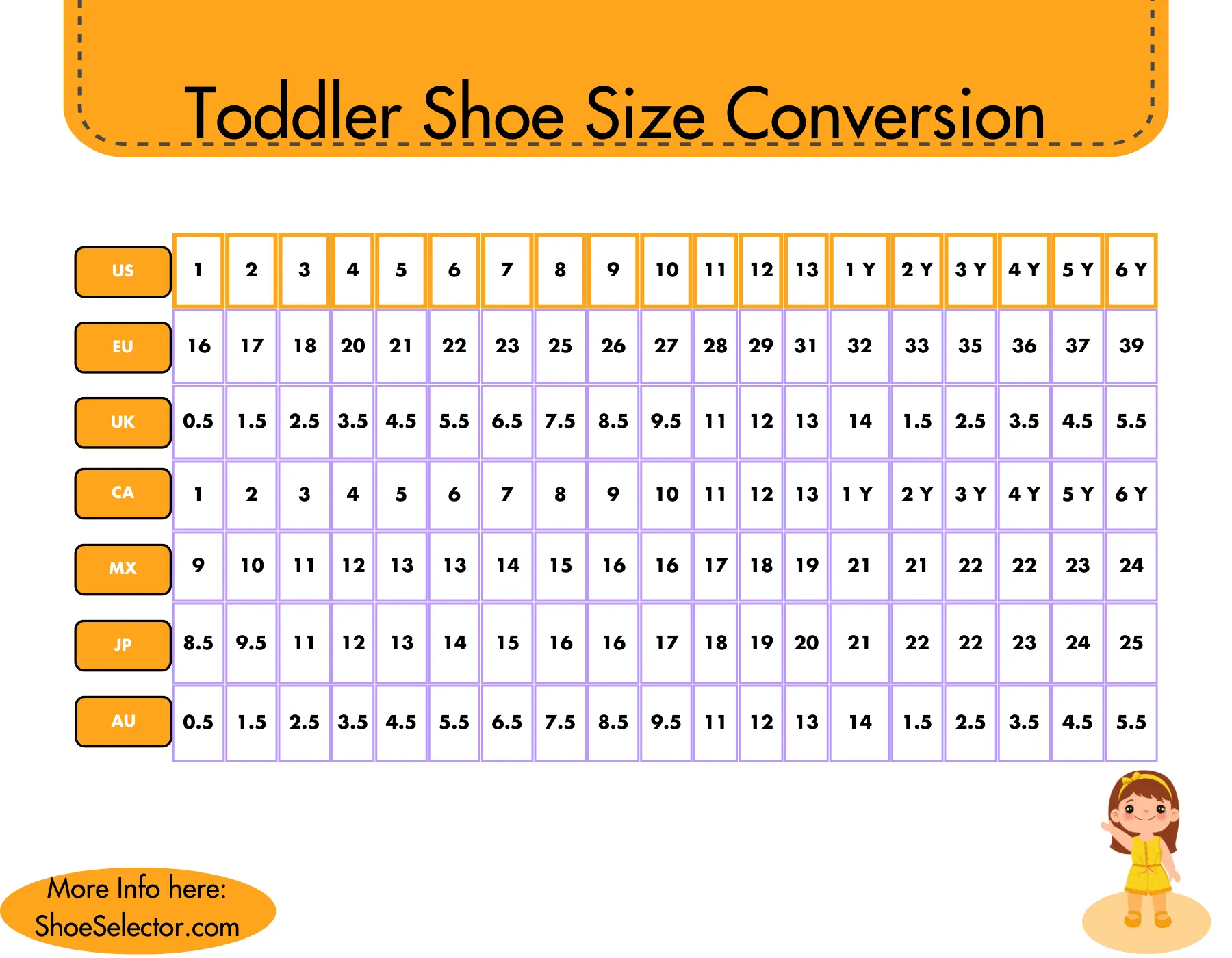
Age Group Foot Length (in inches) Foot Length (in centimeters)
- 2 years old 4 - 4.5 10.2 - 11.4
- 3 years old 4.5 - 5 11.4 - 12.7
- 4 years old 5 - 5.5 12.7 - 13.9
- 5 years old 5.5 - 6 13.9 - 15.2
UK | US | EU | Japan:
- 2 years old 4 - 4.5 10.2 - 11.4 20 - 30 11 - 16
- 3 years old 4.5 - 5 11.4 - 12.7 20 - 30 11 - 16
- 4 years old 5 - 5.5 12.7 - 13.9 30 - 40 16 - 21
- 5 years old 5.5 - 6 13.9 - 15.2 30 - 40 16 - 21
If you’re unsure about what size to get, it’s always best to err on the side of larger shoes.
Toddlers Shoe Sizing Tips and Advice:
- Always have your toddler feet measured before buying new shoes.
- Look for shoes that are easy for your toddler to put on and take off by themselves.
- Choose shoes that provide support and stability, but have a flexible sole.
- When selecting shoes for active toddlers, always choose shoes that are comfortable, well-fitting, and appropriate for the toddler activity level.
Common Toddler Shoe Sizing Mistakes to Avoid:
Buying your toddler the wrong size shoes is a mistake that many parents make. Here are some common toddler shoe sizing mistakes to avoid:
1. Not Measuring Your Toddler’s Feet
2. Buying Shoes That Are Too Big or Too Small
3. Not Checking for Comfort
4. Not Considering Your Toddler’s Activity Level
5. Not Allowing for Growth
How do Perfect Toddler Shoe Sizes Increase from Time to Time?
As your toddler grows, so does their shoe size. Perfect Toddler shoes are designed to accommodate this growth, so you can be sure that your toddler feet will always be comfortable. Just be sure to measure their feet every few months and compare them to the size chart before purchasing new shoes.
What are Infant Shoe Sizes?
Infant shoe sizes are based on the length of your Infant foot in inches. The most common sizes are 0-12 months, 12-18 months, and 18-24 months. You can also find shoes in size XS (0-12 months), S (12-18 months), M (18-24 months), and L (24-36 months).
Why Is It Important To Measure Your Infant’s Feet?
It’s important to measure your Infant feet because they grow quickly! Infants can grow up to two sizes in a single month, so it’s important to check their size often. Measuring their feet will also help you find the right shoes for their foot type.
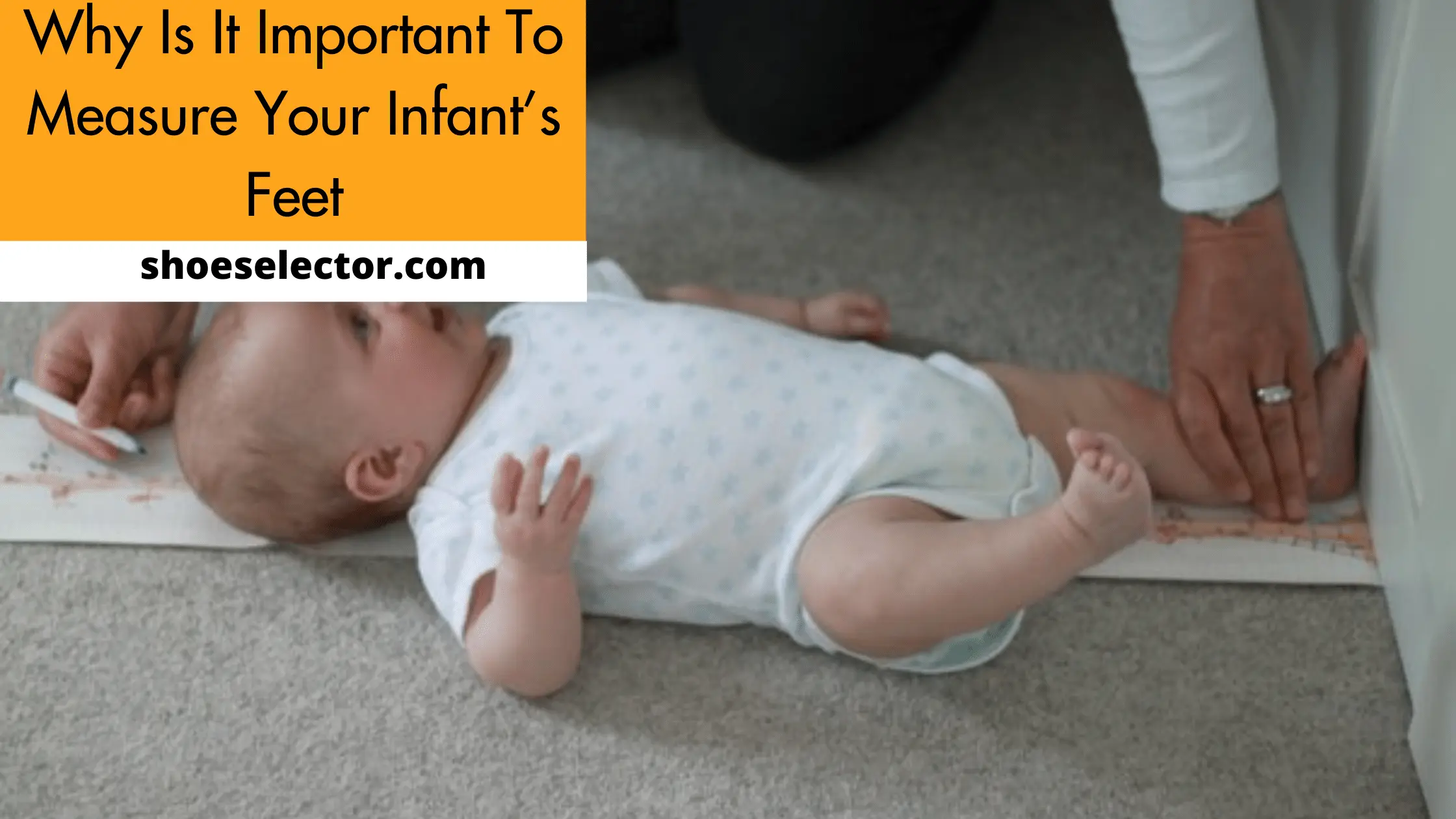
How Do You Know What Size To Buy?
The best way to know what size to buy is to measure your Infant foot. You can do this by placing their foot on a piece of paper and tracing around it. Then, use a ruler or measuring tape to measure from the heel to the toe. Use our chart to find the corresponding size.
How to Measure Your Perfect Infant Shoe Size Feet?
First, you need a hard surface and something to mark with like a pencil or pen. Place the foot on the surface and have your Infant stand up straight.
Next, use a ruler or measuring tape to measure from the heel to the toe.
Finally, use our chart to find the corresponding size.
How to Make Sure The Infant Fit is Correct?
To make sure the infant fit is correct, you should always try on the shoes before purchasing them. Place your Infant foot in the shoe and have them stand up. The shoe should be snug but not too tight. There should also be enough room to wiggle their toes. If the shoe is too big or too small, return it for a different size.
What is the Average Infant Shoe Size By Age in the UK, US, EU, and Japan?
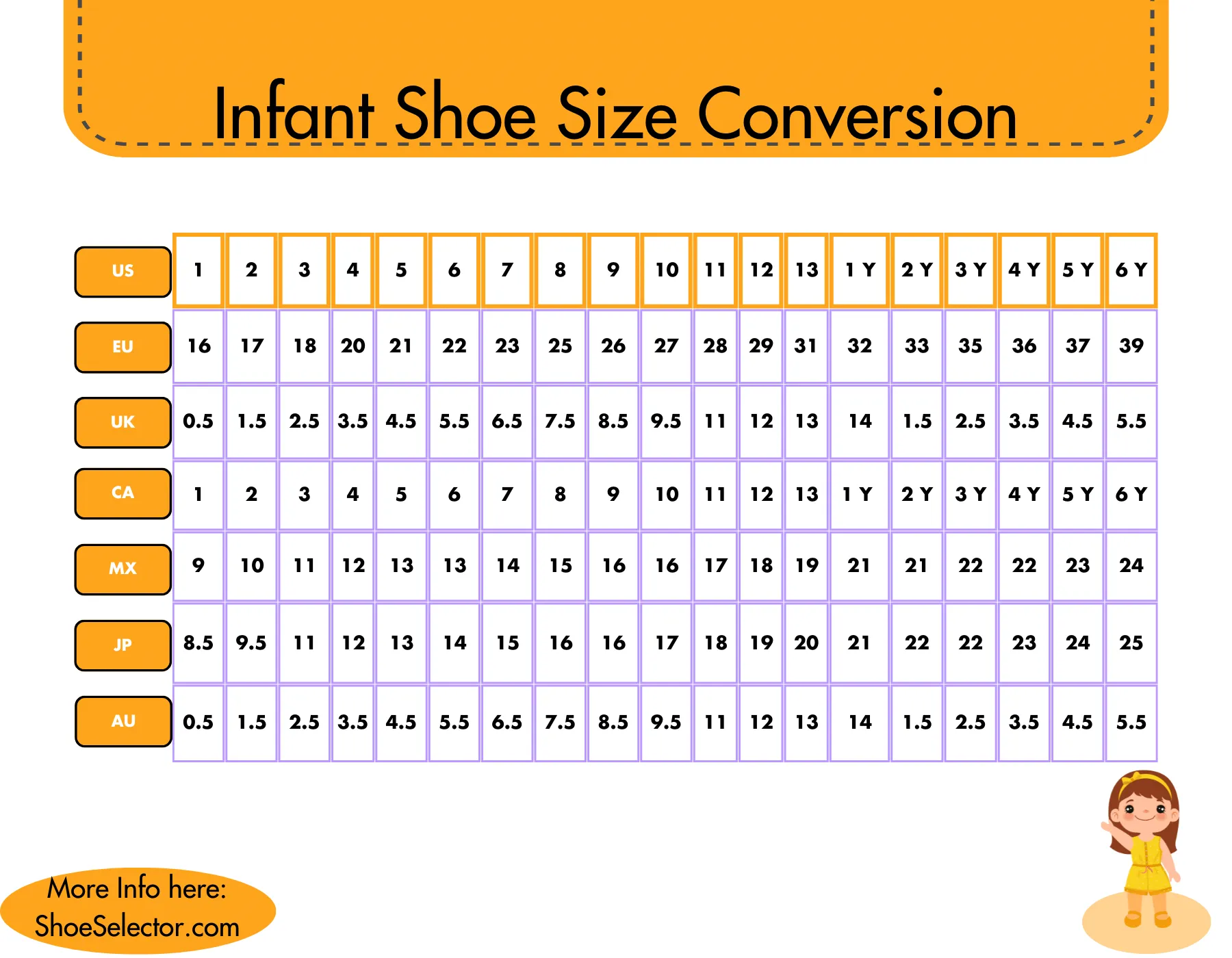
Infant Shoe Size Chart:
- 0-12 months: Size 0-12
- 12-18 months: Size 12-18
- 18-24 months: Size 18-24
UK Shoe Size Chart:
- 0-12 months: Size 11.0 (UK)
- 12-18 months: Size 11.50 (UK)
- 18 - 24 months: Size 12.0 (UK)
US Shoe Size Chart:
- 0-12 months: Size 0.50 (US)
- 12-18 months: Size 0.75 - US
- 18-24 months: Size 0.75 - US
EU Shoe Size Chart:
- 0-12 months: Size 16 (EU)
- 12-18 months: Size 17 (EU)
- 18-24 months: Size 18 (EU)
As you can see, there is a big difference between Infant sizes and UK/US sizes. The EU size is closer to the UK size. So, if you’re shopping for shoes in Europe, it’s best to use the EU size chart. If you’re shopping in the UK or US, it’s best to use the UK/US size chart.
Common Infant Shoe Sizing Mistakes to Avoid:
There are a few common mistakes that parents make when sizing shoes for their infants. Here are a few things to avoid:
- Buying shoes that are too big. It’s tempting to buy shoes that are a size or two larger than your Infant current size, in the hope that they’ll grow into them.
- Buying Shoes That Are Too Small. On the other hand, you don’t want to buy shoes that are too small either. This can be just as harmful as buying shoes that are too big.
When in doubt, always err on the side of caution and go up a size rather than down. You can always put socks or booties on your Infant to make the shoes fit more snugly if they’re too big.
How do Perfect Infant Shoe Sizes Increase from Time to Time?
The average American infant is getting bigger and taller. In fact, according to recent studies, the average newborn Infant girl is almost half an inch taller than her counterparts from 50 years ago.
How do I Convert an Infant Shoe Size to Inches or Centimeters?
To convert an infant’s shoe size to inches or centimeters, you can use the following conversion chart. Just find the infant’s shoe size on the left-hand column, and then read across to find the corresponding measurement in inches or centimeters. Shoe Size (USA) | Shoe Size (CM) | Shoe Size (Inches) 0 | 13.7 cm | 5.39 inches 1 | 14.3 cm | 5.63 inches 2 | 15 cm | 5.91 inches 3 | 15.6 cm / 16.4 cm*| 6.29 / 6.69 inches 4* | 17 cm*| 6.69* inches
What are Baby Shoe Sizes?
There are a few different systems for baby shoe sizes, but the most common one in the United States is the newborn size. This is based on the length of your baby’s foot, and it usually corresponds to a certain age range. For example, most newborn shoes are between 0 and 0.75 inches long.
Why is it Important To Measure Your Baby’s Feet?
It’s important to measure your baby’s feet because proper fitting shoes are essential for healthy foot development. Shoes that are too small can cause your baby’s feet to grow into an abnormal shape, while shoes that are too large can create blisters and put unnecessary pressure on your baby’s feet. By measuring your baby’s feet regularly, you can ensure that they’re always wearing shoes that fit properly.
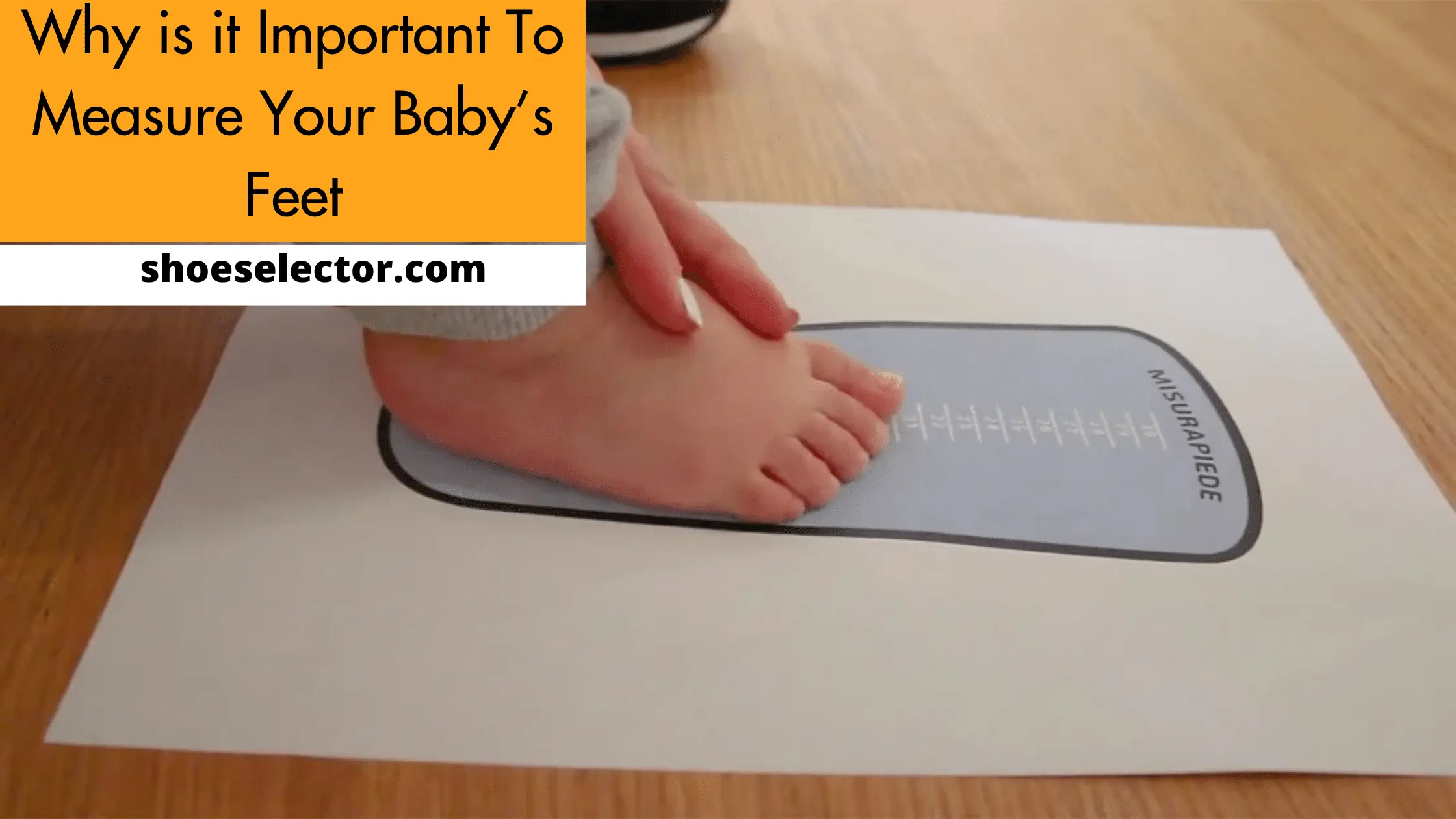
How Do You Know What Size To Buy?
Sizing can be tricky, especially when shopping online. How do you know what size to buy? Will it fit? Is it true to size? These are all valid questions that deserve thoughtful answers. The best way to know what size to buy is to first consult the size chart.
Size charts usually provide detailed measurements of the item in question, so you can compare it to your own measurements and get a sense of how it will fit. If you’re still unsure, reading customer reviews can be helpful. Many reviewers will mention whether an item runs large or small, and this can give you a better idea of what size to buy.
How to Measure Your Perfect Baby Shoe Size Feet?
There are a few different ways to measure your feet, but the most common one is using a tape measure. To do this:
- Simply place the tape measure on the floor and stand on it with your heel against the wall. Make sure that the tape measure is level, then take a reading at the longest point of your foot.
- Once you have your Baby foot measurement, consult a baby shoe size chart to find the right size.
How To Make Sure the Baby Fit is Correct?
There are a few things you can do to make sure that the baby shoe fit is correct.
- Make sure that you buy the shoes from a reputable retailer and that you try them on in person.
- You should also measure your Baby foot before buying shoes to ensure that you get the correct size.
- When trying on shoes, make sure that your Baby has enough room to wiggle their toes and move their feet around.
- The shoes should not be too tight or too loose. You should also check the heel of the shoe to make sure that it is snug against your Baby heel and not too loose.
- If the shoes are too big, you can put heel counters or tongue pads in the shoes to help keep them from slipping off.
What is the Average Shoe Size for a Baby by Age?
- Preemie 0-3 months 2" - 3"
- Newborn 0-6 months 3" - 4"
- Infant 6-12 months 4" - 5"
- Baby 12-24 months 5"-7"
What is the Average Baby Shoe Size by Age UK, US, EU, and Japan?
The average shoe size for a baby by age UK is:
- Preemie 0-12 months D (infant) - E (pre-walker)
- Baby 12-24 months E (pre-walker) - F (Baby)
The average shoe size for a baby by age US is:
- Preemie 0-12 months 0 (infant) - 0.75 (pre-walker)
- Baby 12-24 months 0.75 (pre-walker) - 11 (Baby)
The average shoe size for a baby by age EU is:
- Preemie 0-12 months 16 (infant) - 18 (pre-walker)
- Baby 12-24 months 18 (pre-walker) - 20 (Baby)
The average shoe size for a baby by age Japan is:
- Preemie 0-12 months 11.25cm - 12cm (infant) - 12.75cm (pre-walker)
- Baby 12-24 months 12.75cm (pre-walker) - 13.25cm (Baby)
How to Check Perfect Baby Shoe Size Chart by Numbers?
There is a perfect baby shoe size chart that will work for everyone, because babies come in all different shapes and sizes. However, there are some general guidelines that you can follow to get an idea of what size shoes your baby will need.
To start with, you’ll need to measure your baby’s foot. Use a soft ruler or a piece of paper to measure the length of your baby’s foot from heel to toe. Be sure to measure in inches or centimeters, not shoe sizes!
Once you have the measurement, you can use the chart as a guideline for finding the right-sized shoe.
Common Baby Shoe Sizing Mistakes to Avoid:
There are a few common baby shoe sizing mistakes that parents often make.
- The first is buying shoes that are too big, in the hopes that the Baby will grow into them.
- Another common mistake is buying shoes that are too small, thinking that they will stretch over time.
How do Perfect Baby shoe sizes increase from time to time?
Perfect Baby’s sizes increase in short, medium and long lengths, as well as in widths from narrow to extra wide. You’ll be able to find the perfect fit for your little one’s feet every time and they’ll love the trendy styles and colors of our shoes.
What Age Does Baby Feet Stop Growing?
Most babies’ feet stop growing somewhere between 9 and 12 months old. However, every baby is different and will stop growing at a different time.
What Are Children’s Shoe Sizes?
Children’s shoe sizes vary from brand to brand, and generally, most Children’s start growing at around age 2. By age 5, they typically go up to a size 7. However, the perfect fit and the proper sizing are essential to prevent foot problems later in life. So make sure that you buy children’s shoes that fit correctly, and take their feet measurements at the store.
Why is it Important to Measure Your Children’s Feet?
There are a few reasons why it is important to measure your children’s feet.
- First, it ensures that they are wearing the correct size shoe.
- Second, measuring their feet can help you determine whether they have any foot problems that need to be addressed.
- Finally, it can simply be a fun bonding experience for you and your child.
How to Measure Your Children’s Shoe Size Feet?
- Measure children’s feet by taking a foot measurement while standing on a floor surface.
- Measure each foot at its widest point, just above the ankle bone.
- Use a standard length ruler to measure the longest toe length, with the heel up against the wall, aligned with the curved line. Place the width ruler next to the longest toe and mark the spot where the big toe meets the ruler.
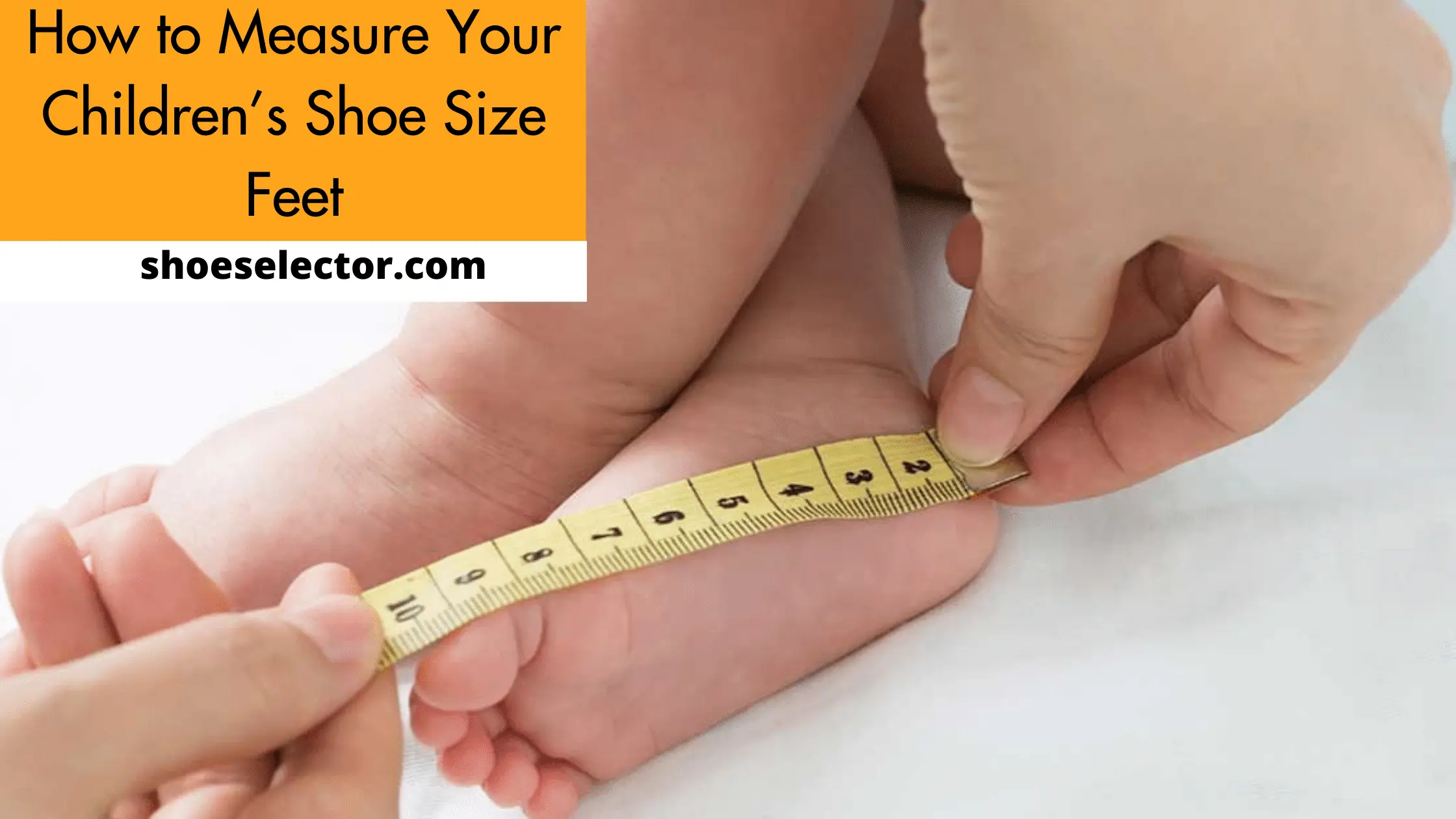
How Often to Size Your Children’s Feet?
When your child has grown up, you can size their shoes to match their feet. You can do this every time they grow by buying new shoes, or else, you can do it once and have them grow into their new shoes. If you choose to size them every time, then you should buy shoes that will last longer.
What is the Average Shoe Size for Children’s by Age?
This varies by gender and age. Children’s usually grow out of their shoes by age 5 or 6, depending on their size, and by that age, their feet are usually around size 8.5, which is the average shoe size for girls and boys.
Average Footwear Shoe Size for a 1-Year-Old:
Footwear shoes for Children’s usually fit around size 2, with most being in the range of 20-22 inches.
Average Footwear Shoe Size for a 2-Year-Old:
The average footwear shoe size for a 2-year-old is 8 ½, which comes from a study of over 10,000 children.
Average Footwear Shoe Size for a 3-Year-Old:
A 3-year-old would generally wear shoe sizes 8-10, which would mean that he’d be between 10 and 12 months old. So, you can expect him to be between 2 and 4 feet tall by then.
Average Footwear Shoe Size for a 4-Year-Old:
The average size of a child’s feet increases around 0.5 inch (1.27 cm) between the ages of one to two, then it remains stable for another two years, and then the size starts to decrease by about 0.2 inches (0.51 cm) per year.
However, in general, we can say that a 4-year-old should wear a size 8.5 shoe.
Average Footwear shoe Size for a 6-Year-Old:
A 6-year-old boy should be wearing a size 12 shoe, with men’s sizes being wider than women’s.
Average Footwear Shoe Size for a 7-Year-Old:
An average footwear shoe size for a 7-year-old is a size of 2.5.
Average Footwear Shoe Size for an 8-Year-Old:
The average shoe size for an 8-year-old is a Men’s US 9.5. For a little girl, a Girls' US 9.5 is a good fit.
Average Footwear Shoe Size for a 9-Year-Old:
An average footwear size for a 9-year-old boy is approximately 7.5. For girls, this falls between 8 and 8.5.
Average Footwear Shoe Size for a 10-Year-Old:
The average shoe size for a 10-year-old boy is 11.5 and for girls 9.5. You can calculate this size easily by adding the width of the foot (7.5 inches for boys and 6.5 inches for girls) with the correct length of the shoe (10.5 inches for boys and 8.5 inches for girls).
What is the Average Shoe Size by Age in the UK, US, EU, and Japan?
The average shoe size in Japan for the ages 4-5, 6-7, 8-9, and 10-11 are as such:
| Average UK Size | Average US Size | Average EU Size | Average Jap Size |
- 4-5 | 8.5 | 7.5 | 7.2 | 8.8
- 6-7 | 9.5 | 8.5 | 8.3 | 9.1
- 8-9 | 10.5 | 9.5 | 9.2 | 9.8
- 10-11 | 11.5 | 10.5 | 9.6 | 10.4
UK - 8½
US - 9
EU - 39
Japan - 39.5
Common Children’s Shoe Sizing Mistakes to Avoid:
- One of the most common mistakes Children’s make is buying adult sizes.
- They end up fitting their feet badly, resulting in a loose fit.
- You can buy your child’s shoes a little large for their feet, but avoid buying shoes that are more than one size too big or the shoe will become a tripping hazard.
How do Children’s Shoe Sizes Increase from time to Time?
The size of children’s shoes changed over the years, but there was a trend. The average size of children’s shoes has increased, which means the feet of growing children are growing bigger.
What to Do if Your Children Are Between Sizes?
If your children are between sizes, you can still use a convertible bed, but you will have to purchase both sizes and combine them together for a single bed. You can then flip one side up to make it the smaller size, and the other side down to make it the bigger size. This will give you a combined bed with the same dimensions as a standard one, but at half the cost.
What are Kids' Shoe Sizes?
Kids’ shoe sizes are given in terms of half sizes, or half shoe sizes. A size 6/1.5 is a half size smaller than a size 8, and a size 4/1.5 is a half size smaller than a size 5.
You can convert these half sizes to full sizes by subtracting one from the other and adding an additional 0.5 size to get the equivalent size. For example, a size 6/1.5 is equivalent to a size 7.25, and a size 4/1.5 is equivalent to a size 3.75.
How to Measure Your Perfect Kids Shoe Size Feet?
- To measure your kids' feet, take their shoes off and place them on a flat surface.
- Now, simply measure the length of their foot from heel to toe.
- Make sure that the measurement is taken from the widest part of the foot. It should be about half of the length of their feet.
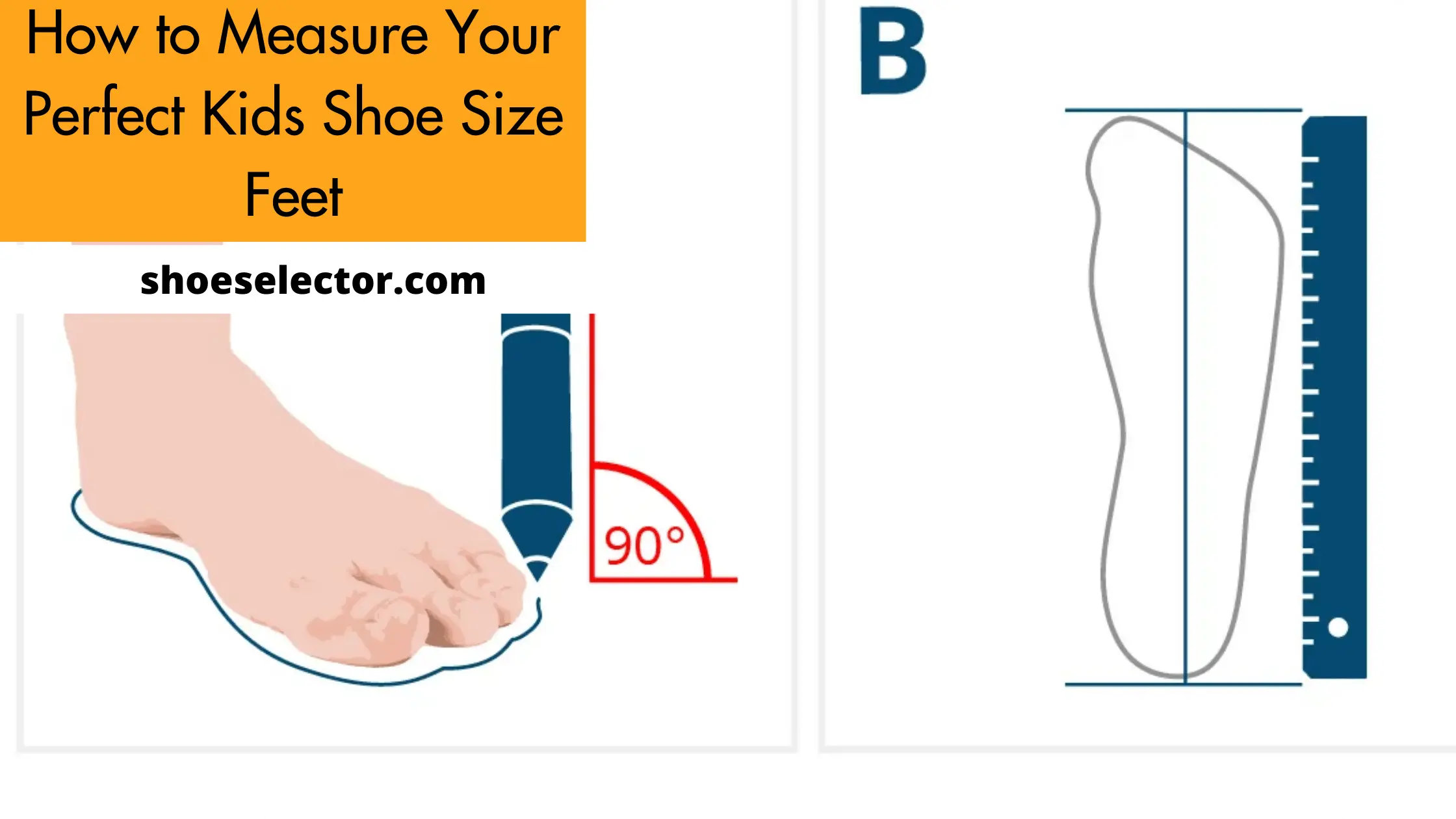
How Often to Size Your Kid’s Feet?
It depends on a variety of factors, including age, gender, and type of shoes. However, you should plan for a minimum of a 2-year interval between sizes. This can be measured by measuring your kids’ feet at least once a year and then comparing it with the chart provided by the manufacturer.
How to Make Sure the Kids Fit is Correct?
As long as the kids are walking around barefoot, the shoe should fit nicely and leave no gaps. But if they’re wearing shoes, you can make sure it fits correctly by following these steps. First, check if the shoe has any laces or a zipper. If not, remove the shoe and try it on. If it fits properly, the shoes are ready to wear. If not, you should tighten the laces or add a zipper to get a better fit.
What is the Average Kids Shoe Size by Age in the UK, US, EU, and Japan?
- In the UK, the average kids shoe size ranges between 2 and 4.5.
- In the US, the average shoe size is around 4.5 to 5.5.
- In the EU, the average shoe size is around 4 to 5.
- In Japan, the average shoe size is around 5 to 7.5.
Kids Shoe Size Calculator:
There are times when you may need to know the size of a kids shoes. Maybe you’re buying them a new pair, or you’re trying to replace an old pair that’s been lost or damaged.
In either case, it can be helpful to have a kid’s shoe size calculator handy. This tool can help you determine the correct size for a kids shoes, based on their age and foot size.
Here are Some Tips to Help you With Shoe Sizing for Kids:
- Start by measuring your kids foot using a ruler or a piece of paper that measures 12 inches wide by 18 inches long.
- Once you have the foot measurement, kids shoe sizes that correspond to this number.
- If you are buying shoes for a kids who is out of range of their usual shoe size, try to find a style that is half a size smaller than what they usually wear. Or, if they are between sizes, go with the larger size.
- It’s also important to make sure that your kids shoes fit well and are comfortable when they are wearing them.
Common Kids Shoe Sizing Mistakes to Avoid:
There are a few common mistakes that kids make when it comes to shoe sizing.
- Not measuring the size of the kids feet correctly
- Buying shoes too small
- Buying shoes too large
- Buying shoes that are not the right style or color
How do Perfect Kids shoe sizes increase from time to time?
As kids grow, their feet grow too! That means that the size of their shoes has to increase from time to time as well. Parents sometimes don’t realize how often their kids' feet grow, so it can be tough to keep up with what size they need.
Things to Know Before Reading the Shoe Size Charts:
There are a few things to remember when reading shoe size charts:
- The size on the chart is not necessarily the size you will need to buy. Children’s feet grow quickly, so you might need to buy a larger size than what is listed on the chart.
- Different brands of shoes often have different sizing. For example, one brand of Kids shoes might run large while another brand runs small.
- Always try on shoes before buying them to ensure they fit properly. This is especially important when buying shoes for Toddlers because their feet are still growing and changing.
- When in doubt, it is always best to err on the side of buying a larger-size shoe. Infant feet will grow, but shoes that are too small can be uncomfortable and cause problems like blisters.
Frequently Asked Questions
How Do You Determine Shoe Sizing for Infants, Toddlers, Baby Kids, and Children's Shoes?
It can be tricky to determine shoe size for infants, toddlers, baby kids, and children because their feet grow and change so much. You might need to go up a size or two from what you would normally buy as an adult.
One way to get an idea of the right size is to trace your child’s foot on a piece of paper and then measure the length and width. You can then use this information to look for shoes that are specifically marked as being for “infants,” “toddlers,” “baby kids,” or “children.” Many stores also have staff who are knowledgeable about shoe sizing and can help you find the right pair of shoes for your child.

